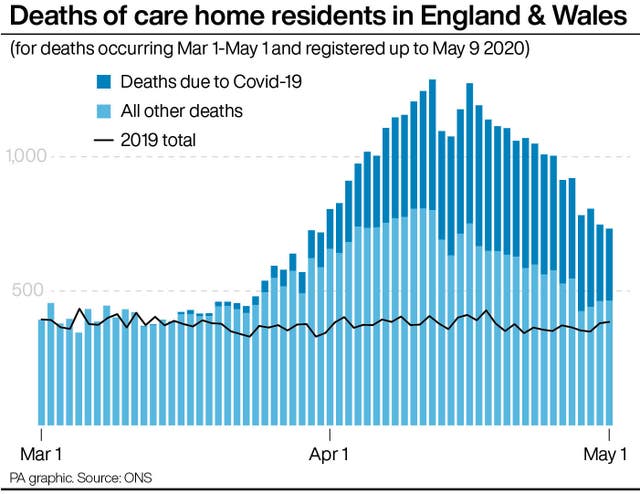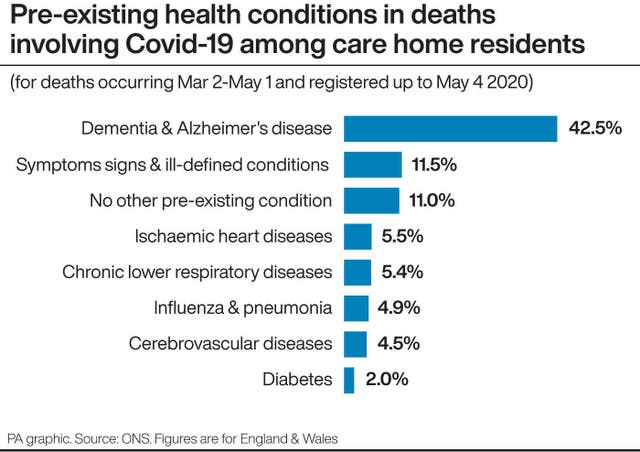More than 12,500 people living in care homes have now died with Covid-19, with the majority dying in their care home, new figures show.
Data from the Office for National Statistics (ONS) reveals that just over one in four of all deaths of care home residents in England and Wales between March 2 and May 1 involved Covid-19.
Of 45,899 care home residents who died during this period, 27% (12,526) had Covid-19 mentioned on their death certificate.
Some 9,039 (72%) of the deaths occurred within a care home and 27% were in hospital.

The latest data includes all care home residents who died with coronavirus either at their care home or in hospital.
Death figure
This pushes the overall care home resident death figure 51% higher than the 8,312 reported by the ONS on Tuesday.
For its latest round-up, the ONS found that Covid-19 was the leading cause of death for male care home residents in England and Wales during the period, accounting for 30.3% of deaths.
Covid-19 was the second leading cause of death in female care home residents, after dementia and Alzheimer’s disease, accounting for 23.5% of deaths.
Of all hospital deaths involving Covid-19 during this period, 14.6% were accounted for by care home residents.
Since March, there has been an increase both in deaths involving Covid-19 and those not involving Covid-19 among care home residents, the ONS data also showed.
Some 73,180 deaths occurred among care home residents in England and Wales up to May 1 this year (and registered up to May 9) – 23,136 more than the same period last year.
Some 12,526 of these “excess deaths” mentioned Covid-19 on the death certificate.
Sarah Deeny, assistant director of data analytics at the Health Foundation, said: “Today’s data – which accounts for care home residents that have died in hospital – shows that previous figures have significantly underestimated the extent of Covid-19-related deaths among residents, which total 12,526 – 51% higher than previously published.

“For all causes of death, the proportion of deaths among care home residents in hospitals has declined from last year.
“While we would expect a high proportion of these deaths to occur within care homes, and in many cases this will be the right choice for patients, this does raise the question of whether more residents should be treated in hospitals and whether they are being provided with high-quality end of life care.
“This worrying data reveals the extent of the human cost of the crisis, which has already taken many lives and affected thousands of families who have lost loved ones.”
Caroline Abrahams, charity director at Age UK, said: “These new authoritative figures provide the most detailed view to date about what’s been going on in care homes and home care, and they tell a pretty alarming story.
“It’s not just the many deaths of older people directly attributed to the virus that cause us concern, but also the spike in deaths accounted for by other things.
“Behind these statistics there are real older people whose lives were tragically cut short, and families and friends left to carry on knowing that in other circumstances their loved ones may have survived.
“For now, the priority has to be to do everything possible to protect older people in receipt of care, and save their lives.
“It is clear that problems remain in accessing enough PPE (personal protective equipment) and tests, and in the last seven days a further 400 care homes reported a Covid-19 outbreak, showing we are still very much in the midst of the crisis.”
Ian Hudspeth, chairman of the Local Government Association’s community wellbeing board, said: “Councils want to play their full part in the national effort to overcome coronavirus, but need help and information to understand where the outbreaks are happening more widely and be able to act quickly to contain them.
“The Government needs to share this vital and up-to-date data with councils, as part of any contact tracing programme.
PPE ordering system
“It is also crucial the Government’s online PPE ordering system is fully operational as soon as possible, so that councils and care providers can directly request that critical protective equipment gets to the front line where it is desperately needed.”
Shadow social care minister Liz Kendall said it was “clear that the virus is having an even bigger impact on care home residents than was first thought”.
She added: “The Government has been too slow to get to grips with this problem.
“Despite recent announcements, there is still complete confusion about testing, with care homes telling MPs they have been unable to access tests.
“The Government’s own Covid-19 recovery strategy can’t guarantee that every care home for the over-65s will even be offered tests until June 6.”
A Department of Health and Social Care spokeswoman said: “Every death from this virus is a tragedy and we are working around the clock to give the social care sector the equipment and support they need to tackle this unprecedented global pandemic.
“This includes continuing to make sure millions of items of PPE are available to care workers, using our increased testing capacity to test care home residents, staff and their families regardless of symptoms and our new £600 million Infection Control Fund to help prevent spread in care homes.”
Related – Cabinet minister defends early coronavirus guidance to care homes

